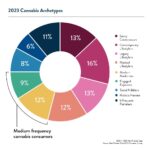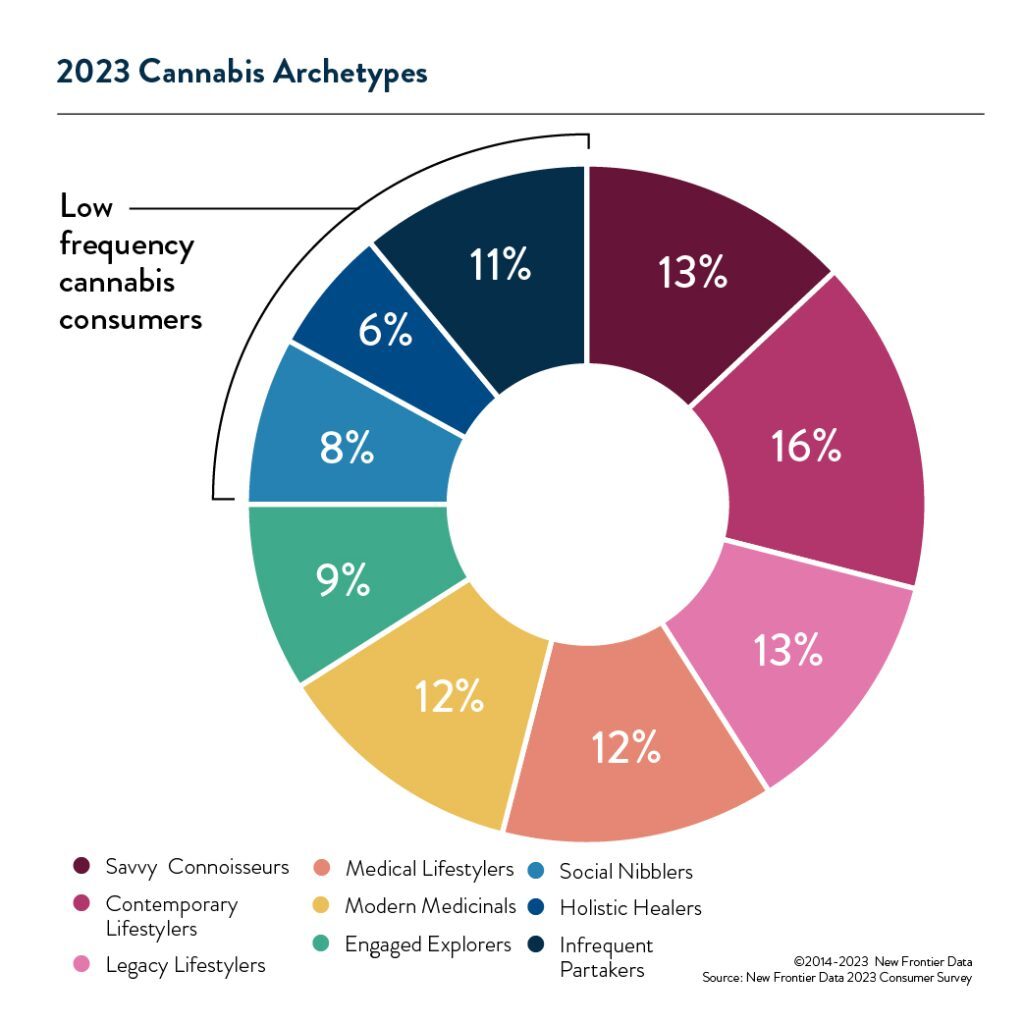2023 Archetypes: Low-Frequency Consumers

2023 Archetypes: Medium-Frequency Consumers
July 11, 2023
Unlocking the Midwest: Cannabis Legalization and Consumer Insights
August 8, 2023By Dr. Molly McCann, Senior Director of Consumer Insights at New Frontier Data
This is the last of three installments on New Frontier Data’s 2023 archetypes. In this blog, we’ll be introducing the low-frequency cannabis consumers. Read about the high-frequency consumers and medium-frequency consumers in our previous blog posts.
Our upcoming report—Cannabis Consumers in America 2023 – Part 2: Exploring the Archetypes—describes New Frontier Data’s nine cannabis consumer archetypes, updated with our 2023 consumer survey data (for analysis about consumers in general, check out Cannabis Consumers in America Part 1: An overview of consumers today.
Many people who are new to cannabis start as infrequent consumers. Some may eventually ramp up their use, and some may continue to only use sporadically. These infrequent consumers tend to have relatively narrow product preferences and motivations for use; for example, they may only use cannabis topicals to manage pain before bed or smoke joints while socializing with friends. Individuals in these archetypes may be new to cannabis, or they could be returning to cannabis use after decades of not using it. Together, the following three low-frequency archetypes account for about a quarter of all cannabis consumers.
Social Nibblers (8% of consumers)
Most Social Nibblers describe their cannabis use as exclusively recreational (as opposed to medical). They use cannabis primarily to relax, often in the context of socializing with friends. These friends are the channel through which most Social Nibblers acquire their cannabis. Social Nibblers exist in all market types, from illicit to adult-use, and prefer non-flower cannabis forms—particularly edibles.
Holistic Healers (6% of consumers)
The majority of Holistic Healers use cannabis exclusively medically (as opposed to recreationally), generally to treat pain or another medical condition, often before bed. Like the Social Nibblers, Holistic Healers prefer non-flower forms of cannabis, notably topicals and tinctures. While most infrequent consumers source cannabis from friends, Holistic Healers are surprisingly likely to source from brick-and-mortar dispensaries, probably owing to their product form preferences—friends are less likely to have the topical and tincture options they want.
Infrequent Partakers (11% of consumers)
Like the Social Nibblers, Infrequent Partakers consider themselves exclusively recreational—as opposed to medical—consumers, and use cannabis to relax, often while socializing with friends from whom they usually acquire their cannabis. Unlike the Social Nibblers, Infrequent Partakers prefer—and many exclusively use—smokable forms of cannabis, especially joints.

Friends and family are an important channel for low-frequency consumers
Whether it’s a lack of comfort with engaging directly with cannabis retail, or a preference for the convenience and social experience of receiving cannabis from friends, Infrequent Partakers and Social Nibblers source cannabis primarily through friends, even if they live in adult-use markets with accessible dispensaries. Their reliance on friends is related to these archetypes’ preference for the most ubiquitous product forms (joints and edibles, respectively), which friends are most likely to have on hand.
While many Holistic Healers also source through friends and family, this archetype relies surprisingly heavily on retail, given how infrequently they use cannabis products. Unlike the Social Nibblers and Infrequent Partakers, Holistic Healers are often seeking out less common product forms, like topicals and tinctures, and can more easily acquire them directly from dispensaries, especially if they are looking for a particular brand or product formulation.
Low-frequency archetypes may be transitionary phases for new or returning consumers
Some consumers may remain in these low-frequency archetypes long-term, only ever partaking once or twice a year when someone passes them a joint at a gathering of friends. But many of the Social Nibblers, Holistic Healers, and Infrequent Partakers are using cannabis for the first time—or for the first time in a legal, accessible context. As such, their use is not only infrequent, it is restricted to limited use cases and product forms. But through positive experiences with products that meet their needs and learning about the varied applications of cannabis, individuals in these archetypes may broaden their relationships with cannabis and transform to a different archetype, using several product types, more frequently, for a wider array of reasons.





